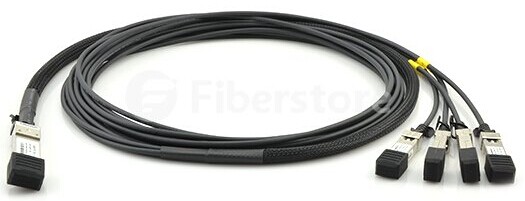A direct attach cable (DAC) is a fixed assembly that is purchased at a given length, with the connector modules permanently attached to each end of the cable. The direct attach cable is designed to use the same port as an optical transceiver, but compared with optical transceivers, the connector modules attached to the DAC leave out the expensive optical lasers and other electronic components, thus achieving significant cost savings and power savings in short reach applications.
Types of DAC
The direct attach cable can be divided into different types according to different criteria. According to the cables used, the direct attach cables include copper cable assemblies and fiber optic cable assemblies. Besides, DAC cable assemblies can also be classified into 10G SFP+ cables, 40G QSFP+ cables, and 120G CXP cables according to the data rate supported by different connector modules.
What’s more, we can also divide the DAC according to the number of connectors on the end of the cable. Most DAC assemblies have one connector on each end of the cable. But there is a special kind of DAC assembly which may have 3 or 4 connectors on one end of the cable. For instance, Cisco QSFP-4SFP10G-CU1M compatible QSFP+ to 4SFP+ passive breakout copper cable from Fiberstore has a single QSFP + module rated for 40-Gbps on one end and four SFP + modules, each rated for 10-Gbps, on the other end.

Direct Attach Copper Cable vs. Active Optical Cable
Direct attach copper cable is interchangeable and hot swappable with fiber optic modules. It supports such multiple protocols as Gigabit & 10G Ethernet, 8G FC, FCoE and InfiniBand, direct attach copper cable is a cost effective solution over optical transceivers. The defect of direct attach copper cable is that it is heavy and bulky, making it difficult to be managed. Furthermore, due to the nature of electrical signals, direct attach copper cable is vulnerable to the effects of electromagnetic interference (EMI), such as undesirable responses, degradation, or complete system failure.
Since the optical fiber is a kind of dielectric (not able to conduct electric current), AOC is also immune to EMI. Compared with direct attach copper cable, the drawback of AOC is that it may be a little expensive for customers. With the benefits of AOCs, such as lighter weight, high performance, low power consumption, low interconnection loss, EMI immunity, AOCs are now considered as the rising star of in telecommunications. For example, QSFP-4X10G-AOC10M from Fiberstore is suitable for very short distances and offers a very cost-effective way to establish a 40-gigabit link between QSFP ports of Cisco switches within racks and across adjacent racks.
Fiberstore DAC Solutions
Fiberstore offers a variety of high speed interconnect DAC assemblies including 10G SFP+ cables, 40G QSFP+ cables, and 120G CXP cables to satisfy the demands from 10G to 100G interconnection. All of the Fiberstore’s direct attach cables can meet the ever growing need to cost-effectively deliver more bandwidth, and they can also be customized to meet different requirements.
No comments:
Post a Comment